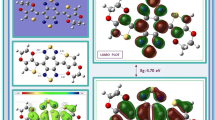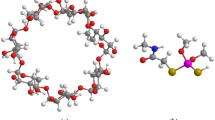Abstract
When heterocyclic monomers are polymerized by electrochemical or chemical methods, they form fully conjugated polymers which have a wide range of applications due to their outstanding electronic properties. Among this class of compounds, thiophene derivatives are widely used due to their chemical stability and synthesis flexibility. With the goal to investigate the torsion barrier of polymer chains, a few units of 3,4-ethylenedioxythiophene (EDOT) were chosen and submitted to molecular mechanics (MM), density functional theory (DFT) and coupled cluster CCSD(T) calculations. This study helps to understand the performance and transferability of force fields used in molecular mechanics and molecular dynamics simulations often used to describe structure–property relationships of those systems. Determination of inter-ring torsion angle was performed in a comparative study using both force field, DFT and CCSD(T) methods. A good agreement was noticed between MM and QC results and highlights the importance of the description of the interactions involving the oxygen atoms present in the structure of EDOT. These observations are related to the α,α-coupling that occurs between the monomer units and yields a linear polymer. DFT HOMO and LUMO orbitals were also presented. Finally, UV–vis spectra of EDOT units were obtained using several levels of theory by means of time-dependent DFT calculations (TD-DFT).







Similar content being viewed by others
References
Roncali J (1992) Conjugated poly(thiophenes): synthesis, functionalization, and applications. Chem Rev 92:711–738. doi:10.1021/cr00012a009
McCullough RD, Lowe RD, Jayaraman M, Anderson DL (1993) Design, synthesis, and control of conducting polymer architectures: structurally homogeneous poly(3-alkylthiophenes). J Org Chem 58:904–912. doi:10.1021/jo00056a024
Yue R, Xu J (2012) Poly(3,4-ethylenedioxythiophene) as promising organic thermoelectric materials: a mini-review. Synth Met 162:912–917. doi:10.1016/ j.synthmet.2012.04.005
Sharp Norton JC, Han MG, Creager S, Foulger S (2012) Electrochemical redox of PEDOT-coated core-shell silica spheres stabilized in a PEG-based hydrogel matrix: modulation of the optical properties by doping with various oxidative mediators. Int J Electrochem Sci 7:3627–3637
Zarras P, Irvin J (2003) Electrically active polymer. Encycl Polym Sci Technol 6:88–134. doi:10.1002/0471440264.pst107
Roncali J, Blanchard P, Frère P (2005) 3,4-Ethylenedioxythiophene (EDOT) as a versatile building block for advanced functional π-conjugated systems. J Mater Chem 15:1589–1610. doi:10.1039/b415481a
Alemán C, Armelin E, Iribarren JI, Liesa F, Laso M, Casanovas J (2005) Structural and electronic properties of 3,4-ethilenedioxythiophene, 3,4-ethilenedisulfanylfurane and thiophene oligomers: a theoretical investigation. Synth Met 149:151–156. doi:10.1016/j.synthmet.2004.12.012
Liu CL, Tsai FC, Chang CC, Hsieh KH, Lin JL, Chen WC (2005) Theoretical analysis on the geometries and electronic structures of coplanar conjugated poly(azomethine)s. Polymer 46:4950–4957. doi:10.1016/j.polymer.2005.03.059
Dkhissi A, Beljonne D, Lazzaroni R (2009) Atomic scale modeling of interfacial structure of PEDOT/PSS. Synth Met 159:546–549. doi:10.1016/j.synthmet.2008.11.022
Zhang L, Li M, Wang C, Wang Y, Shen Y (2013) Electropolymerization and properties of 3,4-ethilenedioxythiophene backbone polymer with tetrathiafulvalene as pedant. J Appl Polym Sci 5:3356–3364. doi:10.1002/app.37803
Barbarella G, Bonghini A, Zambianchi M (1994) Regiochemistry and conformation of poly(3-hexylthiophene) via the synthesis and the spectroscopic characterization of the model configurational triads. Macromolecules 27:3039–3045. doi:10.1021/ma00089a022
Poater J, Casanovas J, Solà M, Alemán C (2010) Examining the planarity of poly(3,4-ethylenedioxythiophene): consideration of self-rigidification, electronic, and geometric effects. J Phys Chem A 114:1023–1028. doi:10.1021/jp908764s
Sun H (1998) COMPASS: an ab initio force-field optimized for condensed-phase applications overview with details on alkane and benzene compounds. J Phys Chem B102:7338–7364. doi:10.1021/jp980939v
Sun H, Mumby SJ, Maple JR, Hagler AT (1994) An ab initio CFF93 all-atom force field for polycarbonates. J Am Chem Soc 116:2978–2987. doi:10.1021/ja00086a030
Rappe AK, Casewit CJ, Colwell KS, Goddard WA III, Skiff WM (1992) UFF, a full periodic table force field for molecular mechanics and molecular dynamics simulations. J Am Chem Soc 114:10024–10035. doi:10.1021/ja00051a040
Mayo SL, Olafson BD, Goddard WA (1990) DREIDING: a generic force field for molecular simulations. J Phys Chem 94:8897–8909. doi:10.1021/j100389a010
Gaedt K, Höltje HD (1998) Consistent valence force-field parameterization of bond lengths and angles with quantum chemical ab initio methods applied to some heterocyclic dopamine D3-receptor agonists. J Comput Chem 19:935–946. doi:10.1002/(SICI)1096-987X(199806)19:8<935::AID-JCC12>3.0.CO;2-6
Materials Studio, Accelrys. © 2001–2011 Accelrys Software Inc
Gaussian 09, Revision A.1, Frisch MJ, Trucks GW, Schlegel HB, Scuseria GE, Robb MA, Cheeseman JR, Scalmani G, Barone V, Mennucci B, Petersson GA, Nakatsuji H, Caricato M, Li X, Hratchian HP, Izmaylov AF, Bloino J, Zheng G, Sonnenberg JL, Hada M, Ehara M, Toyota K, Fukuda R, Hasegawa J, Ishida M, Nakajima T, Honda Y, Kitao O, Nakai H, Vreven T, Montgomery JA Jr, Peralta JE, Ogliaro F, Bearpark M, Heyd JJ, Brothers E, Kudin KN, Staroverov VN, Kobayashi R, Normand J, Raghavachari K, Rendell A, Burant JC, Iyengar SS, Tomasi J, Cossi M, Rega N, Millam JM, Klene M, Knox JE, Cross JB, Bakken V, Adamo, C, Jaramillo J, Gomperts R, Stratmann RE, Yazyev O, Austin AJ, Cammi R, Pomelli C, Ochterski J. W, Martin RL, Morokuma K, Zakrzewski VG, Voth GA, Salvador P, Dannenberg JJ, Dapprich S, Daniels AD, Farkas Ö, Foresman JB, Ortiz JV, Cioslowski J, Fox D J (2009) Gaussian, Inc., Wallingford, CT
Becke AD (1993) A new mixing of Hartree-Fock and local density-functional theories. J Chem Phys 98:1372–1377. doi:10.1063/1.464304
Yanai T, Tew DP, Handy NC (2004) A new hybrid exchange–correlation functional using the Coulomb-attenuating method (CAM-B3LYP). Chem Phys Lett 393:51–57. doi:10.1016/j.cplett.2004.06.011
Vydrov OA, Scuseria GE (2006) Assessment of a long-range corrected hybrid functional. J Chem Phys 125:234109. doi:10.1063/1.2409292
Becke AD (1993) Density‐functional thermochemistry. III. The role of exact exchange. J Chem Phys 98:5648. doi:10.1063/1.464913
Adamo C, Barone V (1999) Toward reliable density functional methods without adjustable parameters: the PBE0 model. J Chem Phys 110:6158–6169. doi:10.1063/1.478522
Xiao H, Tahir-Kheli J, Godard WA III (2011) Accurate band gaps for semiconductors from density functional theory. J Phys Chem Lett 2:212–217. doi:10.1021/jz101565j
Alves LF, Gargano R, Alcanfor SKB, Romeiro LAS, Martins JBL (2011) A chromophoric study of 2-ethylhexyl p-methoxycinnamate. Chem Phys Lett 516:162–165. doi:10.1016/cplett.2011.09.078
Lu SI (2010) The K-band λmax values of the ultraviolet–visible spectra of some hydrazones in ethanol by a TD-DFT/PCM approach. Chem Phys Lett 494:198–201. doi:10.1016/j.cplett.2010.06.010
Bertran O, Torras J, Alemán C (2010) Modeling the structural and electronic properties of an optically active regioregular polythiophene. J Phys Chem C 114:11074–11080. doi:10.1021/jp102223s
Fazzi D, Caironi M, Castiglioni C (2011) Quantum-chemical insights into the prediction of charge transport parameters for a naphthalenetetracarboxydiimide-based copolymer with enhanced electron mobility. J Am Chem Soc 133:19056–19059. doi:10.1021/ja208824d
Ditchfield R, Hehre WJ, Pople JA (1971) Self-consistent molecular-orbital methods. IX. An extended Gaussian-type basis for molecular-orbital studies of organic molecules. J Chem Phys 54:724–728. doi:10.1063/1.1674902
Purvis GD III, Bartlett RJ (1982) A full coupled-cluster singles and doubles model—the inclusion of disconnected triples. J Chem Phys 76:1910–1918. doi:10.1063/1.443164
Bauernschmitt R, Ahlrichs R (1996) Treatment of electronic excitations within the adiabatic approximation of time dependent density functional theory. Chem Phys Lett 256:454–464. doi:10.1016/0009-2614(96)00440-X
Wallace GG, Spinks GM, Kane-Maguire LAP, Teasdale PR (2009) Conductive electroactive polymers: intelligent polymer systems, 3rd edn. CRC, Boca Raton, p 221
Steckler TT, Abboud KA, Craps M, Rinzler AG, Reynolds JR (2007) Low band gap EDOT–benzobis(thiadiazole) hybrid polymer characterized on near-IR transmissive single walled carbon nanotube electrodes. Chem Commun 4904–4906. doi:10.1039/B709672K
Acknowledgments
The authors are grateful for financial support of National Counsel of Technological and Scientific Development (CNPq) and Coordination of Improvement of Higher Education Personnel (Capes) Brazilian agencies. We also thank Prof. David Azevedo (IF-UnB) for his help with the COMPASS force field calculations.
Author information
Authors and Affiliations
Corresponding author
Additional information
This paper belongs to Topical Collection Brazilian Symposium of Theoretical Chemistry (SBQT2013)
Electronic supplementary material
Below is the link to the electronic supplementary material.
ESM 1
(PDF 87 kb)
Rights and permissions
About this article
Cite this article
Durães, J.A., da Silva Filho, D.A., Ceschin, A.M. et al. Investigation of the torsional barrier of EDOT using molecular mechanics and DFT methods. J Mol Model 20, 2405 (2014). https://doi.org/10.1007/s00894-014-2405-3
Received:
Accepted:
Published:
DOI: https://doi.org/10.1007/s00894-014-2405-3




